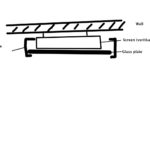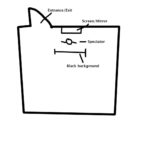Spieglein, Spieglein… – an interactive media installation –
To view a photo in its original size, click on the preview box 🙂
The title refers to a quote from the Snow White fairy tale, “Mirror, mirror (on the wall…)” and therefore deals with one‘s reflection in the mirror. But in the case of this interactive installation the mirror is a virtual reflection on a screen.
How easily can you be erased from social life when your mental health is not in the order it used to be? Or has it ever been ‘in order’? This installation also works with aspects of stigmatisation and isolation. By erasing the face of the viewer, it symbolises the isolation that comes with mental health disorders. To feel unseen, or to feel invisible, can really hurt a lot. But this situation also has an important message to tell. IF the person can be treated properly and get the help she/he needs, it is possible for them to come back and rise like a phoenix from the ashes (also as in a fairy tale), and get back to a life worth living. The cleaning gloves are a metaphor for our society’s desire to clean up, to be tidy and well organised. This creates the standard that every person who suffers from a mental health disorder needs to be either excluded or be brought back to “normal”.
But what is normal? Has it ever existed? And what does a life with a mental health disorder look like? Do we need to adapt to how society tells us to be, or are we able to find our own ways, not only to cope with our problems, but to grow stronger from our situation?
Please find more details how this project works in the video link I sent you below. It shows the basic schematics on how this interactive media installation works. The set up is the following: A mirror is placed near the entrance or exit of the exhibition space. The mirror is actually a screen which only looks like a mirror. A webcam films the person in front of the false mirror and projects her/him on the screen. It creates a virtual reflection of the spectator. When the viewer puts on the two different gloves, she/he can start erasing and painting back her/his own virtual reflection in realtime. And, therefore, they can play with their visibility and invisibility to be able to have a feeling of what it‘s like to feel unseen and to have to reinvent yourself over time.
Born in Tyrol, Verena Tscherner moved to Vienna shortly after her graduation. She studied at the university of music (MDW) in Vienna and graduated in 2014. From October 2018 to June 2019 she made her photo-diploma at School Friedl Kubelka, school for artistic photography. Since October 2019 Tscherner studies digital art, in the class of Ruth Schnell, at the university of applied arts Vienna. She lives and works as a freelance artist in Vienna.


